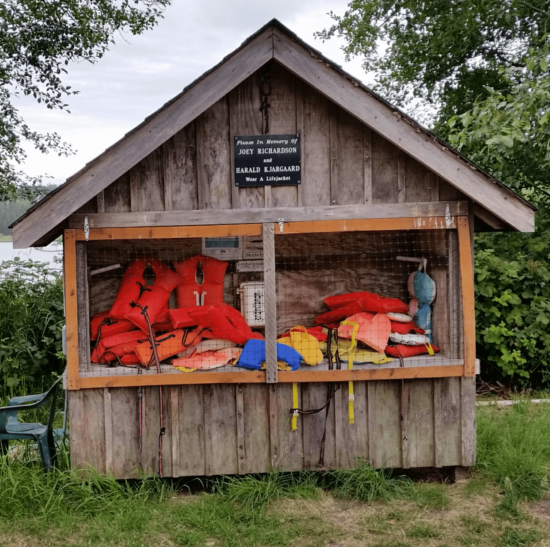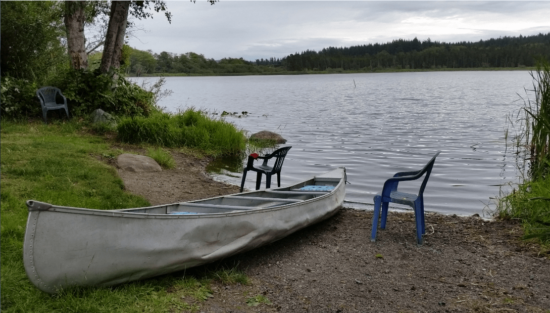
Boater Safety Or Gov. Overreach? Bill Would Require Anglers, Others Aboard Small Craft To Wear PFDs
Editor’s note: Updated Jan. 28, 2020, 10:30 a.m.
In the beautiful, bucolic though also slightly cramped Nanny State of Andy Walgamott — location: King County just north of Seattle, naturally; population: 4; form of government: fathertarianism — camping out in the left lane as well as not using your vehicle’s @$#%@$ turn signal are capital offenses, and everyone is required to wear lifevests while boating.

Doesn’t matter whether it’s just 4 feet deep or you can swim like Michael Phelps, if you’re in a float tube fishing for bass on a lake, plugging for winter-runs out of a drifter, or crabbing in a bay boat, I better see a PFD strapped to your person or I’m writing you up big time, Mister.
Granted, the Nanny State of Andy Walgamott, or NSAW for short, currently does not exactly have jurisdiction over any actual bodies of water (let alone highways, streets or intersections).
But as soon as I finish processing the State of Washington’s application to secede to NSAW, as its High Lord Governor and Protector of People Who Don’t Want Protection From What Literally Can Kill Them, I will have rivers, lakes, reservoirs, inlets, bays — and how.
THAT SAID, TWO OF MY LOCAL LAWMAKERS have taken up the cause of lifejackets for all this legislative session, and while you’d think I’d be donning my personal flotation device to jump on board with them, I’m actually not sure I can support them at this time.
Earlier this month, Reps. Cindy Ryu and Lauren Davis (both D-Shoreline) introduced a bill that would require teens and adults aboard all watercraft less than 19 feet long to wear Coast Guard-approved life vests while the boat is underway.
Broadly speaking, currently only kids 12 and under are, though a PFD per person needs to be available on board.
Last week HB 2443 had a hearing in Ryu’s Housing, Community Development & Veterans
“We’ve had some members of a church who lost their family members years ago, but also more recently, and any time you lose a child, even if they’re grown up, it’s devastating to their family and they mourn for that loss for years and years, if not forever,” said Ryu, the prime sponsor. “Just like the seat belts, if we can save a life — probably a lot more — by making sure that everyone who possibly can is wearing a life jacket when they’re on a ship, especially a smaller vessel or even a paddle board, a canoe, then I think it’s definitely worth all the money and time in the world.”

Jim Virgin of the Paddle Sports Advisory Committee for the Washington State Parks and Recreation Commission said he was in favor of the bill.
“Simply stated, life jackets save lives,” Virgin said, adding, “I also do dive recovery down in Vancouver, Washington, and I’ve seen the direct impact of dealing with recoveries as it happens. I’m hoping to get myself out of that job.”
“Wearing a life jacket or a PFD is the most important thing that boaters can do to prevent accidental drownings, and the majority of recreational-related drownings occur on smaller vessels and without the use of PFDSs,” Rowe stated.
But he also considered it a conversation starter, not a done deal.
“Understanding that it’s difficult to craft a one-size-fits-all policy related to manage mandatory PFD usage, we are interested to hear from recreational boaters about their positions on this legislation,” Rowe said.
Members of the local boating industry said the bill had caught them off guard.
“Frankly, we’re really proud of the importance of safety as placed in our culture at NMTA,” said Peter Schrappen of the Northwest Marine Trade Association [full disclosure, a Northwest Sportsman advertiser]. “The last thing we want is for people to think that boating is not safe. That would deter them from going on the water. I definitely appreciate your leadership on this issue, Rep. Ryu, but was caught flat footed when this was bill was dropped.”
“I’m looking forward to working with you as we move forward,” Schrappen added, “but to echo my colleague Doug’s comments, this would cast a very large net in a short amount of time and I don’t think we’re quite ready there.”
Doug would be Doug Levy of the Recreational Boating Industry of Washington.
“We take a backseat on safety to nobody. We were the ones that brought you the boater education card and worked on it for four years, and that boater education card has brought the level of fatalities down, per State Parks data,” Levy said. “This is an emotional topic and we never like to see any lives lost, but this is a really breathtaking change, folks … This is not just 13 and under; this is whether you’re 23, 43, 63.”
“We design the legislative process to be thoughtful and to get out and talk to people and work issues out and have a lot of vetting of them,” Levy added.
Even as Thomas O’Keefe of American Whitewater pointed out some pretty grim statistics that support PFD use — “Three-quarters of boating fatalities are due to drowning and Coast Guard data shows that 84, 85 percent of those people were not wearing life jackets and that the use of alcohol was a leading contributing factor” — he questioned whether the focus should be legislation or education.
“I think it’s critical that this body continues to fund and support those efforts [state parks boating programs] because at the end of the day, we can have a law on the books but what really matters is the education and outreach on this stuff,” he said.
Outside the halls of power, the bill also caught the eye of avid — and safety conscious — Puget Sound and river angler Chase Gunnell.
“On my 16-foot drift boat I’m a stickler about informing guests of PFD locations, throw cushions, throw bag use, and boat reentry immediately upon boarding. And PFDs are mandatory at the captain’s discretion, depending on the guests and water conditions,” he said.
“But for the state to require adults to wear PFDs pretty much all the time on all waters is unnecessary overreach that would be a significant change for river anglers in particular,” Gunnell added.
That is language that will resonate strongly with Washington fishermen, an independent bunch that doesn’t like anyone telling them how to rig their rods or what lures to use, let alone mandating wearing a life jacket on waters they may have fished without a problem for years or decades.

I HAVE SPENT MORE THAN A LITTLE TIME on the state’s waters in pursuit of its salmon, steelhead, Dungeness, rainbows, largemouth and other species, and to me a few select moments spotlight the importance of always wearing a lifejacket.
Three drift boat incidents on Westside rivers … drunken outings aboard canoes during my younger days that I look back on now and shake my head about … sharing a boat with the memory of a drowned angler a few years ago.
Camping with my family on Lopez Island over the Fourth of July, I had a few hours to break away and fish Hummel Lake. As I hadn’t brought my kayak, I asked the plunkers at the launch if it was OK to use any of the half-dozen rowboats and canoes scattered around the parking lot.
They said sure, go right ahead — and also strongly recommended I grab a life jacket from the Washington State Parks-inspired life-jacket loaner program kiosk. I was going to anyway, as I’ve worn one every time I’ve been out on the water for the past 15-plus years.
But as I loaded my gear I found out why they were so adamant: I was taking out the same canoe another angler had earlier in the season, but who had fallen in.

They told me it took a week before the body of Salvador Gallegos was found, by a remotely operated underwater vehicle outfitted with sonar to see among the weeds.
We may never know why that canoe overturned the day he took it out — perhaps due to the same buffeting winds that made it hard to control when I fished — but the San Juan County Sheriff’s report noted simply, “He wasn’t wearing a life preserver.”
It’s hard to understand why not, what with so many available at the launch. But then, why hadn’t I worn one for so many years?
I guess that boats and belief in our own fallible skills provide a false sense of safety. It’s a bravado that occasionally leads to death.
All it takes is a gust of wind, a mistimed lean, cold water, weeds too thick to swim through …

LAST FRIDAY, REP. RYU PROPOSED AMENDMENTS to her bill.
Those include limiting it to “human powered” watercraft, i.e., canoes, pontoons, drift boats, row boats, kayaks; deleting the requirement they be less than 19 feet long; and exempted competitive paddlers, squirt boat riders, and those using stand-up paddle boards while tethered to one by a leash or practicing yoga 100 feet from shore from having to wear PFDs.
Though no action was subsequently taken on them by the full committee last week, the bill is slated to again be considered by the Housing, Community Development & Veterans this Friday starting at 10 a.m.
In this short, 60-day session, the deadline to pass non-budgetary bills out of committee in their house of origin is Feb. 7.
Even though I wear a life vest and think others should too, I also think the best approach here is to have a wider, longer conversation that includes Washington’s small boaters, especially anglers, while continuing productive outreach efforts on boating safety.
After all, we live in a democracy, not the (though still great) Nanny State of Andy Walgamott.
Meanwhile, these are the rules as they apply to boating and life jackets on Washington waters, per State Parks:
All vessels (including canoes, kayaks and stand up paddle board) must have at least one U.S. Coast Guard-approved life jacket (PFD) for each person on the boat. In addition to that requirement, one:
- Coast Guard-approved throwable flotation device must on board vessels 16 feet or longer. Canoes and kayaks are exempt from this requirement.
- Children 12 years old and younger must wear a Coast Guard-approved life jacket at all times when underway in a vessel less than 19 feet in length, unless in a fully enclosed area.
- Each person on board a personal watercraft (PWC) and anyone being towed behind a boat must wear a Coast Guard-approved life jacket
